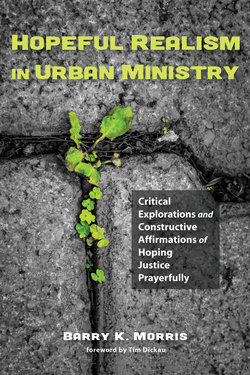Hopeful Realism in Urban Ministry

Реклама. ООО «ЛитРес», ИНН: 7719571260.
Оглавление
Barry K. Morris. Hopeful Realism in Urban Ministry
Chapter 1—Proposal of Hopeful Realism
Chapter 3—Urban Ministry Dynamics and Triad Intimations
Chapter 4—Hope via Moltmann and Urban Ministry Intimations
Chapter 5—Justice via Niebuhr and Urban Ministry Intimations
Chapter 6—Prayer via Merton and Urban Ministry Intimations
Chapter 7—Longhouse Ministry and Networking
Chapter 8—Summary Considerations and Conclusions
Appendix A: The Merton and New Monasticism Check and Balance
Appendix B: Networks’ Viva Voce Testimonies and Inducing Central Story Line
Bibliography
Отрывок из книги
Now I’m not one to lose hope. I keep on hoping. I still have faith in the future. But I’ve had to analyze many things over the last few years and, I would say, over the last few months. I’ve gone through a lot of soul searching and agonizing moments, and I’ve come to see that we have many more difficult days ahead. And some of the old optimism was a little superficial, and now it must be tempered with a solid realism. And I think the realistic fact is that we still have a long, long way to go.1 —Martin Luther King Jr.
There are pervasive pressures, fierce forces, and competing interests confronting urban ministries today. Hitting brick walls and encountering forced options come to mind.2 How often a ministry runs into a virtual dead-end and faces the dire possibilities of having to end the whole mission or admit that the actual options of a ministry are a lot more constrained than those touted during a year end fund-raising campaign. There is also the issue of weariness and for some of us, an eventual burnout. As one veteran urban ministry commentator has frankly noted, there come times when there are obvious signs of “success” although outcomes are less than predictable, shortcut temptations are rife, and the possibilities of falling into weariness and cynicism are close at hand. Barbara Brown Taylor expressed it well:
.....
The tension of contemplation-action was deemed the purview of monastics. Contemplation was thought to be a deeper, quieter dimension of prayer, accompanied by meditation practices, and action was understood to be the counter-balance in the work within and around the monastery. The “new monastics” proffer a creative complement, a check-and-balance interplay. Dietrich Bonhoeffer and his life-long interpreter, Eberhard Bethge, affirm the twinning of prayer with justice (as does the Thomas Merton Society). The Franciscan, Richard Rohr, further illustrates this tension. The Canadian Anglican, Ron Dart, has retrieved the life witness of George Grant for his adoption of the contemplative and the active monastic poles.82 To some extent, this book will illustrate Dart and the others’ approach through A Community Aware (ACA) network.
Secondly, the literature indicates a renewal of broad-based community organizing. Active in dozens of American, Canadian, and British cities, (and beyond) the Industrial Areas Foundation model has endured, albeit sensitively revised and more pacefully applied. It offers a crucial mediating link between theological, social, and ethical principles and the immediate and concrete level of pastoral or emergency assistance. This book will illustrate this process by way of the Metro Vancouver Alliance (MVA) network.
.....